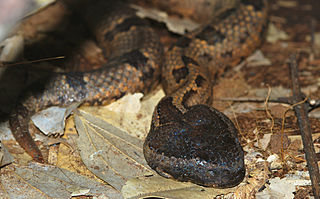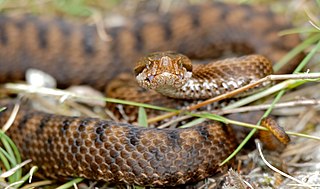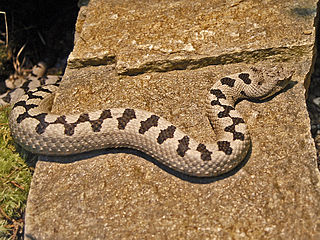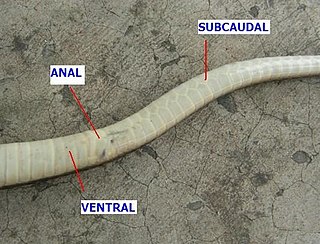Related Research Articles

Crotalus stephensi is a venomous pitviper species found in central and southern Nevada and adjacent California. Common names include panamint rattlesnake, panamint rattler, Owens Valley rattler, and tiger rattlesnake.

Ovophis monticola is a venomous pitviper species found in Asia. Currently, two subspecies are recognized, including the nominate subspecies described here. Recent taxonomic work suggests that most of these should be considered as separate species. IUCN has already evaluated O. m. makazayazaya as Ovophis makazayazaya.

Protobothrops jerdonii is a venomous pit viper species found in India, Nepal, Myanmar, China, and Vietnam. Three subspecies are currently recognized, including the nominate subspecies described here.

Trimeresurus erythrurus, commonly known as the red-tailed bamboo pitviper, redtail bamboo pit viper, and redtail pit viper is a venomous pit viper species found in South Asia and Myanmar. No subspecies are currently recognized.

Trimeresurus gramineus, known as the bamboo pit viper, Indian green pit viper, or common green pit viper, is a venomous pit viper species found in the southern and north eastern parts of India. It is the type species for the genus Trimeresurus.

Trimeresurus purpureomaculatus is a venomous pit viper species native to India, Bangladesh and Southeast Asia. Common names include: mangrove pit viper, mangrove viper, and shore pit viper.

Trimeresurus stejnegeri is a species of venomous pit viper endemic to Asia. Two subspecies are currently recognized, including the nominate subspecies described here.

Crotalus helleri is a highly venomous pit viper subspecies found in southwestern California and south into Baja California, Mexico.

Vipera is a genus of venomous vipers. It has a very wide range, being found from North Africa to just within the Arctic Circle and from Great Britain to Pacific Asia. The Latin name vīpera is possibly derived from the Latin words vivus and pario, meaning "alive" and "bear" or "bring forth"; likely a reference to the fact that most vipers bear live young. Currently, 21 species are recognized.
Ophryacus is a genus of venomous pit vipers endemic to Mexico. The name is derived from the Greek word ophrys, which means "brow", and the Latin word acus, which means "needle", an allusion to the characteristic horn-like scales over the eyes. Currently, three species are recognized and no subspecies.

Vipera aspis is a venomous viper species found in southwestern Europe. Its common names include asp, asp viper, European asp, and aspic viper, among others. Bites from this species can be more severe than from the European adder, V. berus; not only can they be very painful, but also about 4% of all untreated bites are fatal. The specific epithet, aspis, is a Greek word that means "viper." Five subspecies are currently recognized, including the nominate subspecies described here.
In snakes and amphibians, the canthus, canthal ridge or canthus rostralis, is the angle between the flat crown of the head and the side of the head between the eye and the snout, or more specifically, between the supraocular scale and the rostral scale. It is defined as a sharp ridge in many viperids, but is rounded in most rattlesnakes, for example.
Echis pyramidum aliaborri is a venomous viper subspecies endemic to northern Kenya.

Montivipera raddei albicornuta is a venomous viper subspecies endemic to Iran.. It is a subspecies of Montivipera raddei.

Vipera transcaucasiana is a venomous viper species endemic to parts of Georgia and northern Turkish Anatolia.

Snakes, like other reptiles, have skin covered in scales. Snakes are entirely covered with scales or scutes of various shapes and sizes, known as snakeskin as a whole. A scale protects the body of the snake, aids it in locomotion, allows moisture to be retained within, alters the surface characteristics such as roughness to aid in camouflage, and in some cases even aids in prey capture. The simple or complex colouration patterns are a property of the underlying skin, but the folded nature of scaled skin allows bright skin to be concealed between scales then revealed in order to startle predators.
In scaled reptiles, the ocular scales are those forming the margin of the eye. The name originates from the term oculus which is Latin for "eye" and, in the broadest sense, refers to a scale associated with the eye. The numbers of these scales present, and sometimes the shapes and sizes, are some of many characteristics used to differentiate species from one another.
In scaled reptiles, supraocular scales are (enlarged) scales on the crown immediately above the eye. The size and shape of these scales are among the many characteristics used to differentiate species from each another.

In snakes, the subcaudal scales are the enlarged plates on the underside of the tail. These scales may be either single or divided (paired) and are preceded by the anal scale.
In snakes, the canthals are the scales along the upper surface of the canthus rostralis. They are located behind the level of the prenasal/postnasal suture and before the supraocular. They are also described as being located along the edge of the crown between the internasals and the supraoculars. If these are large scales that contact each other along the midline, they are more properly referred to as prefrontals.
References
- ↑ Wright AH, Wright AA. 1957. Handbook of Snakes. Comstock Publishing Associates (7th printing, 1985). 1105 pp. ISBN 0-8014-0463-0.
- ↑ Dixon, James Ray (2000). Amphibians and Reptiles of Texas: With Keys, Taxonomic Synopses, By James Ray Dixon. ISBN 9780890969205.